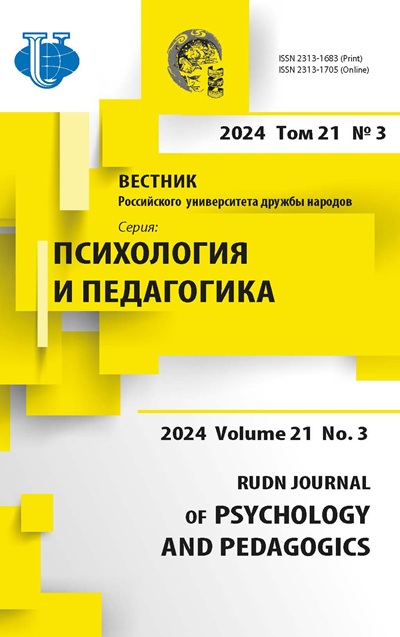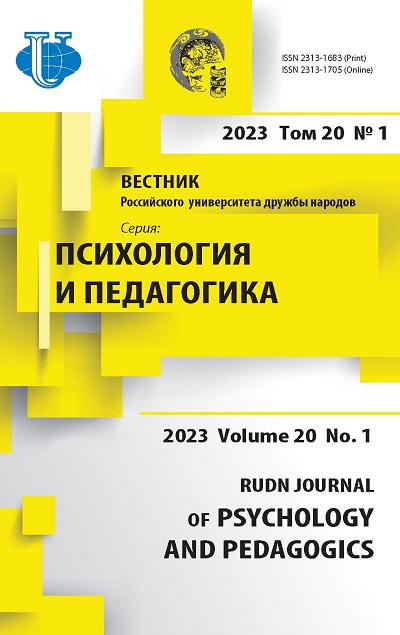The Role of Civic Identity, Religiosity, Sex, and Education in Young People's Commitment to Various Forms of Social Activity
- Authors: Shamionov R.M.1
-
Affiliations:
- Saratov State University
- Issue: Vol 20, No 1 (2023)
- Pages: 7-23
- Section: PERSONALITY AND CONTEMPORARY CHALLENGES
- URL: https://journals.rudn.ru/psychology-pedagogics/article/view/34283
- DOI: https://doi.org/10.22363/2313-1683-2023-20-1-7-23
- EDN: https://elibrary.ru/DGMKWG
Cite item
Full Text
Abstract
The problem of social activity of young people is in the field of research attention of psychology, sociology, law, pedagogy and other sciences. The social activity of young people is an important basis for the dynamic and innovative development of society. Studying the factor structure and the role of socio-psychological characteristics in integral (combined) forms of social activity is an important task of modern social psychology. The aim of the study is to investigate the structure of social activity of young people and, based on a path analysis, to determine the role of civic identity, religiosity, sex, and education in commitment to various (combined) forms of social activity. The study involved 305 people aged M = 21.2; SD = 2.95 (men - 35.4%), 17.4% of the participants were married. A questionnaire aimed at fixing socio-demographic characteristics, civic identity, religiosity, attitudes of social activity, and developed scales aimed at measuring commitment to various types of social activity were used. To assess this commitment, previously developed scales were used. Civil identity was determined using A.N. Tatarko’s scale. Descriptive statistics methods, factorial, correlation, regression and path analyses were also applied. It has been shown that the four-component (civil-political, protest-subcultural, spiritual-educational, leisure) factor model of forms of social activity is acceptable for all the analyzed dimensions. As a result of modeling, a direct relationship between gender and education is established with the manifestations of educational-developing, civil-political and leisure, educational-developing activity respectively. Civil identity is a positive factor in civil-political activity and a negative factor in protest-subcultural activity. At the center of the model is the commitment to spiritual and educational activity, which contributes to the prediction of all the other forms of activity, i.e., civil-political and leisure (directly), and protest-subcultural (indirectly). The facilitating or hindering and mediating role of civic identity, religiosity, gender, and education in commitment to various forms of social activity can be used in organizing social activity of young people as well as in developing “guided” socialization programs.
About the authors
Rail M. Shamionov
Saratov State University
Author for correspondence.
Email: shamionov@mail.ru
ORCID iD: 0000-0001-8358-597X
Doctor of Sciences (Psychology), Professor, is Head of the Department of Social Psychology of Education and Development
83 Astrakhanskaya St, Saratov, 410012, Russian FederationReferences
- Arendachuk, I.V. (2018). Dynamics of value and meaning characteristics of social activity of modern youth. RUDN Journal of Psychology and Pedagogics, 15(3), 287–307. (In Russ.) https://doi.org/10.22363/2313-1683-2018-15-3-287-307
- Arendachuk, I.V., Klenova, M.A., & Usova, N.V. (2022). Features of educational and developmental activity of students under forced self-Isolation. Psychological Science and Education, 27(2), 82–95. https://doi.org/10.17759/pse.2022270207
- Badaeva, N.N., & Osipova, N.V. (2018). Social activity of young people: volunteering and volunteerism. The Kazan Socially-Humanitarian Bulletin, (2), 9–13. (In Russ.) https://doi.org/10.24153/2079-5912-2018-9-2-9-13
- Balabanova, E.S. (2018). Social and psychological approach to the study of young people’s social activity. Znanie. Ponimanie. Umenie, (3), 210–223. (In Russ.) https://doi.org/10.17805/zpu.2018.3.19
- Berdyaev, N.A. (1918). The fate of Russia: Experiences in the psychology of war and nationality. Moscow: G.A. Leman i S.I. Sakharov Publ. (In Russ.)
- Bocharova, E.E. (2018). Regulatory and worldview factors of various forms of social activity of young people. Izvestiya of Saratov University. Educational Acmeology. Developmental Psychology, 7(4), 333–345. (In Russ.) https://doi.org/10.18500/2304-9790-2018-7-4-333-345
- Brown, C.L., Gibbons, L.E., Kennison, R.F., Robitaille, A., Lindwall, M., Mitchell, M.B., Shirk, S.D., Atri, A., Cimino, C.R., Benitez, A., MacDonald, S.W.S., Zelinski, E.M., Willis, S.L., Schaie, K.W., Johansson, B., Dixon, R.A., Mungas, D.M., Hofer, S.M., & Piccinin, A.M. (2012). Social activity and cognitive functioning over time: A coordinated analysis of four longitudinal studies. Journal of Aging Research, 2012, 287438. https://doi.org/10.1155/2012/287438
- Chan, M., & Guo, J. (2013). The role of political efficacy on the relationship between Facebook use and participatory behaviors: A comparative study of young American and Chinese adults. Cyberpsychology, Behavior, and Social Networking, 16(6), 460–463. https://doi.org/10.1089/cyber.2012.0468
- Ferguson, R., Gutberg, J., Schattke, K., Paulin, M., & Jost, N. (2015). Self-determination theory, social media and charitable causes: An in-depth analysis of autonomous motivation. European Journal of Social Psychology, 45(3), 298–307. https://doi.org/10.1002/ejsp.2038
- Grant, P.R., Bennett, M., & Abrams, D. (2017). Using the SIRDE model of social change to examine the vote of Scottish teenagers in the 2014 independence referendum. British Journal of Social Psychology, 56(3), 455–474. https://doi.org/10.1111/bjso.12186
- Gumilev, L.N. (1989). Ethnogenesis and the Biosphere of the Earth. Leningrad: Leningrad University. (In Russ.)
- Hair, J.F., Black, W.C., Babin, B.J., & Anderson, R.E. (2009). Multivariate data analysis (7th ed.). Upper Saddle River: Pearson Prentice Hall.
- Hardy, S.A., Dollahite, D.C., Johnson, N., & Christensen, J.B. (2015). Adolescent motivations to engage in pro-social behaviors and abstain from health-risk behaviors: A self-determination theory approach. Journal of Personality, 83(5), 479–490. https://doi.org/10.1111/jopy.12123
- Kharlanova, E.M. (2011). Research of social activity of students. Historical and Socio-Educational Idea, (5), 173–178. (In Russ.)
- Klenova, M.A. (2019). Protest activity and its psychological content in the context of young people’s socio-political activity. Izvestiya of Saratov University. Educational Acmeology. Developmental Psychology, 8(4), 362–367. https://doi.org/10.18500/2304-9790-2019-8-4-362-367
- Kumykov, A.M., Lyuev, A.Kh., Zhabelova, G.A., & Zhuravel, K.N. (2017). Students’ social activities as a guarantee of their professional success. Higher Education in Russia, (3), 127–132. (In Russ.)
- Lavrentyev, A.V. (2014). Social activity of volunteers. Volunteer, (3), 6–12. (In Russ.)
- Lebedeva, N.M. (2009). Cultural values and attitude to innovation in Russia and China. Almanac of Modern Science and Education, (11–2), 188–192. (In Russ.)
- Maximova, S.G., Noyanzina, O.E., & Omelchenko, D.A. (2017). Construction of the general index of social exclusion of the elderly people: Example of three Siberian regions. Contemporary Problems of Social Work, 3(3), 104–112. https://doi.org/10.17922/2412-5466-2017-3-3-104-112
- McFarland, D.A., & Thomas, R.J. (2006). Bowling young: How youth voluntary associations influence adult political participation. American Sociological Review, 71(3), 401–425. https://doi.org/10.1177/000312240607100303
- Nasledov, A.D. (2013). IBM SPSS 20 Statistics and AMOS: Professional Statistical Data Analysis. St. Petersburg: Piter Publ. (In Russ.)
- Omelchenko, E., & Polyakov, S. (2017). The concept of cultural scene as theoretical perspective and the tool of urban communities analysis. The Russian Sociological Review, 16(2), 111–132. (In Russ.) https://doi.org/10.17323/1728-192X-2017-2-111-132
- Oosterhoff, B., Ferris, K.A., & Metzger, A. (2017). Adolescents’ sociopolitical values in the context of organized activity involvement. Youth & Society, 49(7), 947–967. https://doi.org/10.1177/0044118x14560528
- Pecherkina, I.F. (2017). Determinants of protest moods. Tyumen State University Herald. Social, Economic, and Law Research, 3(4), 86–97. (In Russ.) https://doi.org/10.21684/2411-7897-2017-3-4-86-97
- Petukhov, V.V. (2016). Crisis and protection of the citizens' labour rights. Sociological Studies, (11), 86–96. (In Russ.)
- Sedova, N.N. (2009). Leisure-time activities of Russian citizens. Sociological Studies, (12), 56–68. (In Russ.)
- Seigfried-Spellar, K.C., & Lankford, C.M. (2018). Personality and online environment factors differ for posters, trolls, lurkers, and confessors on Yik Yak. Personality and Individual Differences, 124, 54–56. https://doi.org/10.1016/j.paid.2017.11.047
- Shamionov, R.M. (2018). Social activity of personality and groups: definition, structure and mechanisms. RUDN Journal of Psychology and Pedagogics, 15(4), 379–394. (In Russ.) https://doi.org/10.22363/2313-1683-2018-15-4-379-394
- Shamionov, R.M. (2019). Social activity of youth: a systematic diachronic approach. Russian Psychological Journal, 16(1), 166–188 (In Russ.) https://doi.org/10.21702/rpj.2019.1.8
- Shamionov, R.M. (2021). Social activity and risk propensity of students with autonomous and dependent types of subject regulation. Social Psychology and Society, 12(1), 94–112. (In Russ.) https://doi.org/10.17759/sps.2021120107
- Shamionov, R.M., & Arenkov, A.P. (2016). Value attitudes and civil identity of youth. Human. Community. Management, 17(3), 35–48. (In Russ.)
- Shamionov, R.M., Grigoreva, M.V., Arendachuk, I.V., Bocharova, E.E., Usova, N.V., Klenova, M.A., Sharov, A.A., & Zagranichnyi, A.I. (2020). Psychology of social activity. Moscow: Pero Publ. (In Russ.)
- Shchemeleva, I.I. (2016). Social activity of student youth: Levels and stages of social activity management. Sotsiologiya Obrazovaniya, (7), 16–25. (In Russ.)
- Shelepova, S.N. (2009). Social activity of youth cohorts in structure of contemporary social and political process. Power and Management in the East of Russia, (2), 147–154. (In Russ.)
- Sherman, L.E., Greenfield, P.M., Hernandez, L.M., & Dapretto, M. (2018). Peer influence via Instagram: Effects on brain and behavior in adolescence and young adulthood. Child Development, 89(1), 37–47. https://doi.org/10.1111/cdev.12838
- Sokhadze, K.G. (2017). Social activity of the Russian youth: The scope and restraining factors. RUDN Journal of Sociology, 17(3), 348–363. (In Russ.) https://doi.org/10.22363/2313-2272-2017-17-3-348-363
- Tatarko, A.N. (2011). Social capital as an object of psychological research. Moscow: MAKS Press. (In Russ.)
- Terekhova, T.A. (2015). Structure concept of personal innovative activity. Psychology in Economics and Management, 7(1), 5–15. (In Russ.) https://doi.org/10.17150/2225-7845.2015.7(1).5-15
- Trotsuk, I.V., & Sokhadze, K.G. (2014). Social activity of the youth: Approaches to the assessment of forms, motives and factors in the contemporary Russian society. RUDN Journal of Sociology, (4), 58–74. (In Russ.)
- Ushkin, S.G. (2018). “People against”: Protests and protesters in virtual social networks. Moscow: INFRA-M Publ. (In Russ.) https://doi.org/10.12737/monography_5b5ffb29e84668.61830970
- Vasileva, E.N., & Poltavskaya, M.B. (2015). Economic and social activity of population as an indicator of social capital formation. University Proceedings. Volga Region. Social Sciences, (4), 113–119. (In Russ.)

















